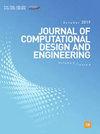生成式早期建筑可视化:融入建筑师风格训练模型
IF 4.8
2区 工程技术
Q1 COMPUTER SCIENCE, INTERDISCIPLINARY APPLICATIONS
引用次数: 0
摘要
本研究介绍了一种使用生成式人工智能(AI)的建筑可视化新方法,特别强调文本到图像(txt2img)技术,以显著改善建筑、工程和施工行业从初始设计阶段开始的可视化流程。通过创建 >10,000 张图片,将建筑师的个人风格和特点融入住宅模型中,体现了基础人工智能模型的有效性。此外,还整合了各种建筑风格,以增强可视化过程。这种方法需要对相似率较低的风格进行额外的训练,这就需要大量的数据准备工作,并将其整合到基础人工智能模型中。这项技术在多个场景中都被证明是有效的,它显著提高了建筑可视化图像制作的效率和速度。我们的研究凸显了人工智能在设计可视化领域的巨大潜力,强调了该技术正朝着促进以用户为中心的个性化设计应用方向转变。本文章由计算机程序翻译,如有差异,请以英文原文为准。
Generative Early Architectural Visualizations: Incorporating Architect's Style-trained Models
This study introduces a novel approach to architectural visualization using generative artificial intelligence (AI), particularly emphasizing text-to-image (txt2img) technology, to remarkably improve the visualization process right from the initial design phase within the architecture, engineering, and construction industry. By creating >10,000 images incorporating an architect's personal style and characteristics into a residential house model, the effectiveness of base AI models. Furthermore, various architectural styles were integrated to enhance the visualization process. This method involved additional training for styles with low similarity rates, which required extensive data preparation and their integration into the base AI model. Demonstrated to be effective across multiple scenarios, this technique markedly enhances the efficiency and speed of production of architectural visualization images. Highlighting the vast potential of AI in design visualization, our study emphasizes the technology's shift toward facilitating more user-centered and personalized design applications.
求助全文
通过发布文献求助,成功后即可免费获取论文全文。
去求助
来源期刊

Journal of Computational Design and Engineering
Computer Science-Human-Computer Interaction
CiteScore
7.70
自引率
20.40%
发文量
125
期刊介绍:
Journal of Computational Design and Engineering is an international journal that aims to provide academia and industry with a venue for rapid publication of research papers reporting innovative computational methods and applications to achieve a major breakthrough, practical improvements, and bold new research directions within a wide range of design and engineering:
• Theory and its progress in computational advancement for design and engineering
• Development of computational framework to support large scale design and engineering
• Interaction issues among human, designed artifacts, and systems
• Knowledge-intensive technologies for intelligent and sustainable systems
• Emerging technology and convergence of technology fields presented with convincing design examples
• Educational issues for academia, practitioners, and future generation
• Proposal on new research directions as well as survey and retrospectives on mature field.
 求助内容:
求助内容: 应助结果提醒方式:
应助结果提醒方式:


